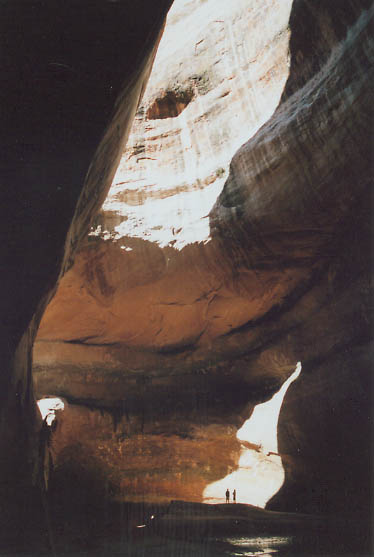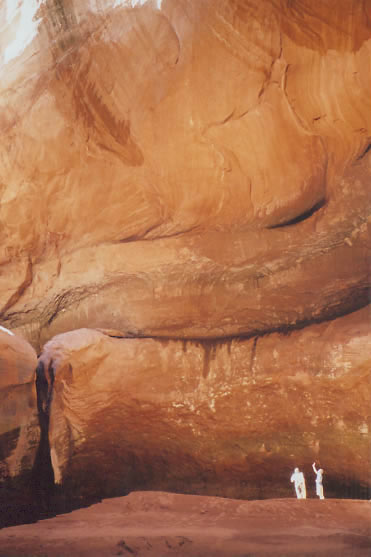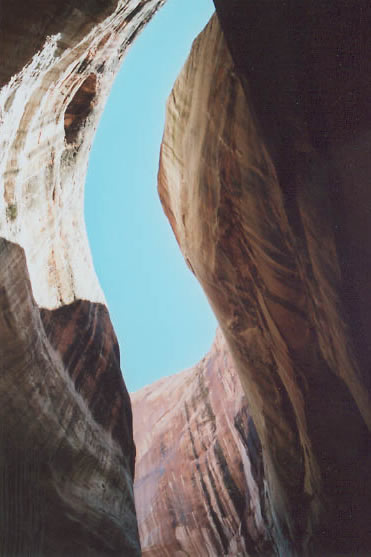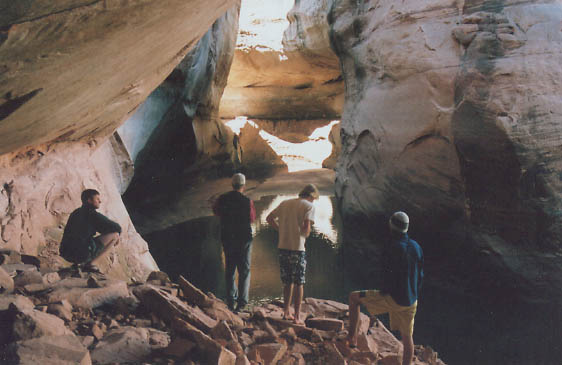

It looked almost exactly like Phil Hyde’s photograph.
I first saw Hyde’s classic 1964 image of Glen Canyon’s "Cathedral in the Desert" more than 25 years ago. Even then, a full decade had come and gone since the rising waters of Lake Powell inundated this extraordinary work of Nature in 150 feet of stagnant fluid. For most of us, it was as if the Cathedral simply didn’t exist anymore. Only Abbey was wise enough to remind all of us that the Cathedral and the rest of Glen Canyon weren’t gone at all; they were, he insisted, simply in "liquid storage." He was more right than he even knew.
Two years ago, when the drought had already pulled the reservoir level down by 90 feet, I traveled with Rich Ingebretsen, the president of the Glen Canyon Institute (GCI), to Lake Powell. We went by boat from Hall’s Crossing to the "Escalante Arm" of Lake Powell, then turned left up a narrow side canyon to the place we thought the Cathedral should be. We guessed right.
It was still difficult to gauge our location from old photos because we were floating sixty feet above the old canyon floor. But as we made a tight turn to the left, we spotted the top of the waterfall that once marked the upstream terminus of the Cathedral, just four or five feet beneath us, still submerged.
We were that tantalizingly close.
We wondered, as we reluctantly departed later that day, if this was as close as we’d ever come. Climatologists even then were predicting a fundamental shift in weather patterns in North America and many scientists predicted that Lake Powell would continue to fall. They were right.
By this spring, Lake Powell had dropped another 60 feet; according to GCI’s calculations, the Cathedral should be completely out of the water—Rich and I decided to take another look.
Two weeks ago, we traveled again to the Cathedral via motorboat, the very form of transportation that would become obsolete if the reservoir ever runs dry, and both Rich and I noted the contradiction. The lake has made it almost impossible to explore much of Glen Canyon by any other means. So there we were, in a $20,000 rented motorboat, spewing a spray of lake water in our wake, trying to grow accustomed to the smell of 2-cycle motor oil and the roar of the outboard engine (I brought ear plugs), in order to see one of the most stunning sights on Earth, and one that no one had viewed in almost 40 years.
Oh the irony.
It took an hour to go from Hall’s Crossing to the mouth of the Escalante River and then up Clear Creek to a point where the canyon appeared to close in. It was just as Harlon Beamont and Burnett Hendrix, two writers for National Geographic had noted a half century before (see Rich’s article on the naming of the Cathedral on page 17). We were still in the boat, passing over the skeletal remains of cottonwoods that once filled this magnificent canyon with colors and aromas unmatched anywhere. But there was a slot at the back of the chamber, easier seen now than then, which allowed us to move a bit farther upstream. We made one final turn to the right...there it was.
She had been perfectly preserved in almost all respects. The waterfall now flowed freely and the spring runoff cascaded over the sculptured lip of the drop-off and spattered in a pool fifty feet below. The ancient dark desert varnish around the waterfall had not faded in 40 years. The concoidal striations that were so clearly visible in Hyde’s images from 1964 were just as sharply defined. We looked at each other, almost in disbelief...we found ourselves speaking in whispered tones.
It had been a long time since I’d seen and heard silence like that.
We traveled back to the talus slope where Hyde had taken his 1964 photo (at the time the reservoir was already rising and Hyde knew the scenes he was shooting would be lost within a year). Incredibly, even the broken rocks had changed little; we found one large flat boulder near the top of the talus that must have served as the ultimate viewpoint. Ingebretsen kept saying softly, "This is where Hyde stood...this is where Brower stood." And it was still there, just waiting for Nature to expose the rock and for us to return.
We all noted the seeps oozing from the canyon walls and a subtle hint of green around those wet places in the Navajo sandstone. Nature was already at work ...restoration! Along the wash bottom, signs of new growth were everywhere. We could see how the runoff continued to scour the canyon of sediments and push it farther downstream, toward the Gulf of California where it ultimately must someday be allowed to go.
And, from time to time, we came upon an old beer can or piece of rope or lost thermos cup—the detritus of the last 40 years of motorized recreation in this holy chamber. But what surprised us was how little garbage there was to be found.
The Cathedral in the Desert, without any help from us, was, in the most tranquil way imaginable, one tiny step at a time, restoring itself. Trying to put back what we had taken away. All it needs from us is Time...that most precious of all commodities.
But there’s the Rub.
All the hard work and good intentions of the Glen Canyon Institute, or the inspired words of Ed Abbey, or the regularly featured rants from this publication have had absolutely nothing to do with the Cathedral’s emergence from its watery grave. The fact that the Will of Nature has coincided with our pleas and laments is totally unexpected and a shock and a surprise to us all. I’m too cynical to think that Nature intended to be our partners in all this–she’d be just as agreeable to drowning us in a sudden desert flash flood as it would members of the Bureau of Reclamation. I don’t believe Nature takes sides, even when one side wants to kill her.
But there is an opportunity. Now that Nature has shown her will, the least we can do is join her. Even a few Lake Lovers are beginning to concede, from what they’ve recently seen, that Glen Canyon is significantly more impressive above the water line than beneath it. And of course, there is a growing awareness of the slowly re-emerging Glen Canyon across the West and across America (ABC News recently traveled with Ingebretsen to the Cathedral and spent almost a day there...look for it to appear on "ABC Nightline" in the near future.)
But how do we help Glen Canyon save itself?
The easy answer is to leave it alone. Convincing supporters of the reservoir won’t be easy at all...it might be impossible. But if it turns out that this year’s snowpack in the Rocky Mountains is an aberration, and the scientists are right (see Ingebretsen’s statistics on page 14), and if as a result, the reservoir continues to shrink, the Pro-Lake Powell arguments may become irrelevant.
Then what?
This has been a point of contention among many of wilderness’s staunchest defenders and Glen Canyon is no exception. The environmental movement is traveling in directions I never dreamed possible, just a decade ago. Saving wild lands was never meant to be tied to economic development. Or even to human spiritual renewal...we tried to save wilderness for its own sake. Glen Canyon is no different. I would willingly give up the easy access to Cathedral in the Desert and resign myself to never seeing it again, if that kind of sacrifice meant that it might be saved. Any of us should be willing to make the same kind of commitment.
It gets more difficult each year to embrace a ‘lost cause’ that I can still feel good about. But Glen Canyon is still one of them.
And who knows...as we motored out of the Cathedral, we were already aware that this year’s Spring Runoff will be massive and that the reservoir will rise at least 30 feet, perhaps 50, maybe more. If the scientists are wrong, and I believe that’s happened before, this may be Cathedral in the Desert’s one brief moment to see the light of day.
But I will take comfort in knowing that she really is down there, "in liquid storage," waiting for an enlightened future to let her shine again.
NEWS FROM THE FUTURE!
No one can accurately predict the future, whether it’s the river flow of the Colorado River or the future of Moab...but it’s fun to speculate. Reviewing the current news of the day, several ‘visions of the future’ come to mind. I can almost see the headlines---20 years from now...
FORMER MOABITE ORDERED TO SEEK ‘ANGER MANAGEMENT THERAPY FOR RECORD 27TH TIME
Former Grand County Councilman Rex Tanner, now a resident of Laughlin, Nevada, was ordered by a Nevada Circuit Court judge to seek ‘anger management therapy’ for a record 27th time, according to the "Laughlin Daily Herald."
Moab residents may recall Tanner’s first publicly recorded angry outburst and abusive comments, aimed at fellow Councilperson Joette Langianese, during a regularly scheduled Council meeting in 2005. Council chairman Jerry McNeely canceled the meeting when the vitriol became too intense.
Tanner, known for his spirited, ‘tell-it-like-it-is-and-to-hell-with-everybody-who-disagrees-with-me’ approach to politics won both enemies and admirers during his brief reign as an elected representative in Grand County.
"Well," recalls former councilperson Langianese, "you always knew where you stood with Rex and he always knew where he stood with me...of course, sometimes he stood right over me and when the yelling got too up close and personal, I just wish someone would have offered him a set of ear plugs."
Tanner, now a keno dealer at Bob’s Casino in Laughlin, faced numerous anger management problems over the years. His latest outburst stems from an incident at the casino on December 26, 2024, when an excited customer spilled a pale ale on Tanner’s keno apron. Tanner was heard to shout, "Do that again, you little twerp and I’ll drop you like a rented mule!"
A brief scuffle ensued which was subsequently stopped by two casino security guards. Both Tanner and the unidentified twerp were charged with creating a public disturbance. Tanner was required to pay a fine and undergo mandatory management therapy. However, the judge warned Tanner that further outbursts would not be tolerated. The judge hinted that new anger management medications, recently made available, would be the next step in correcting Mr. Tanner’s emotional problems.
"The Court believes you are a menace to society," said the Judge, to which Tanner replied angrily, "That’s what YOU are, but what am I?"
THE BATTLE OVER UTAH
WILDERNESS CONTINUES....April 2025
It’s difficult to believe but both opponents and proponents of a Utah BLM Wilderness bill have been fighting over legislation for more than 40 years, and some wonder if this impasse will ever be overcome.
But Scott Groene, longtime director of the Southern Utah Wilderness Alliance (SUWA) said today at a sparsely attended press conference, that SUWA and the Utah Wilderness Coalition were on the verge of a major breakthrough by finally offering a wilderness bill acceptable to Congress.
"We believe that after our latest citizens’ inventory, we have a real handle on the wilderness that’s still out there."
Groene told a stunned audience that the inventory reveals more than 86 million acres of available wilderness in Utah. "Yes," Groene replied to questions, " I am well aware that the number is more than the total amount of acreage in the entire state, but we really don’t believe that should be an impediment to this bill. We simply included properties in other states that are owned by Utah residents."
Rod Decker, the senior correspondent for KUTV in Salt Lake City asked if it was true that SUWA includes Temple Square in its wilderness inventory.
"That is mostly true," Groene said guardedly, "but we are going to allow some cherry stemming of Temple Square sidewalks and we are fairly certain the Temple itself does not have all the components for wilderness....we just don’t think there’s enough solitude in the Celestial Room."
Meanwhile, anti-wilderness advocate Brian Hawthorne, former director of AccessUSA and the leader of the Blue Ribbon Panel for Open Access offered his organization’s own proposal at a similarly near-empty press conference in Cedar City.
"Our people have been out there on their ATVs and we’ve gone up one side of the state and down the other, and we’ve been able to locate 317 acres of real wilderness. That’s what our inventory says."
Hawthorne identified the inaccessible pinnacles of numerous rock spires and monuments throughout the state, including several well-known climbing rocks near Moab, Utah as "possibly having wilderness characteristics ...we couldn’t get our ATVs up them, so they must be wilderness. Otherwise we stand by our count."
In the early 1990s, pro- and anti-wilderness forces lined up along respective acreages of 5.4 million acres versus 1.3 million acres. Today that gap has clearly grown significantly. Has this gap inflamed the public?
A Dan Jones poll in the Deseret News says not. Of the 1345 Utah citizens polled over the wilderness issue, 76% replied, "Don’t care," "Don’t know enough to answer," or "Never heard of wilderness."
"STILES ROAD?"
TALK ABOUT BAD KARMA
Just a short note about this issue’s "Take it or Leave it" picture. I’d put together enough frequent flyer miles for another free ticket to Australia and I spent a lot of time this winter wandering the back roads of WA.
I love exploring maps almost as much as the ride itself and I spotted a ‘familiar’ dirt road near the peaceful coastal town of Kalbarri, north of Perth...it had my name on it.
Perfect, I thought. So I traveled up to Kalbarri, careful to stay off the main highways and away from the road trains, looking forward to the peace and quiet of the tiny town at the mouth of the Murchison River.
There, just a few miles down the coast from Kalbarri was ‘Stiles Road’...it’s the gateway to the biggest housing development to hit the north coast in years.
And just across from Stiles Road? Coming soon, the Kalbarri ECO-LODGE....they expect tourist visitation and second-home construction to increase exponentially in the coming years.
Once again...God is screwing with me.











